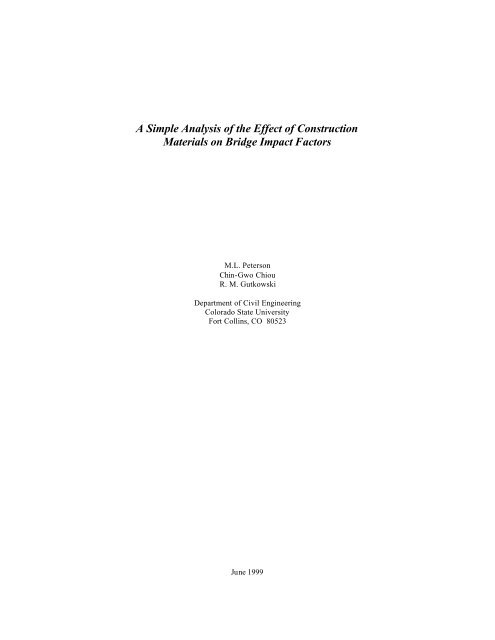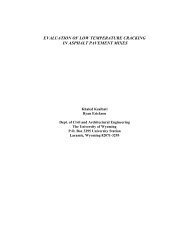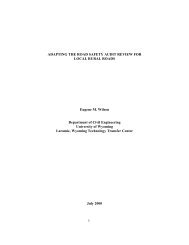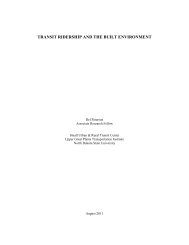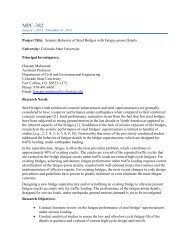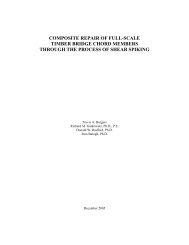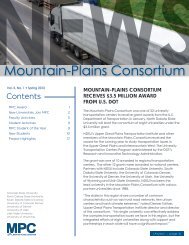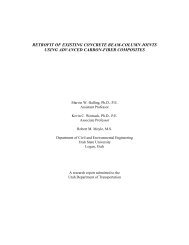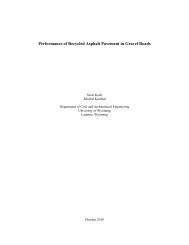MPC-99-105 - Mountain-Plains Consortium (MPC)
MPC-99-105 - Mountain-Plains Consortium (MPC)
MPC-99-105 - Mountain-Plains Consortium (MPC)
You also want an ePaper? Increase the reach of your titles
YUMPU automatically turns print PDFs into web optimized ePapers that Google loves.
A Simple Analysis of the Effect of Construction<br />
Materials on Bridge Impact Factors<br />
M.L. Peterson<br />
Chin-Gwo Chiou<br />
R. M. Gutkowski<br />
Department of Civil Engineering<br />
Colorado State University<br />
Fort Collins, CO 80523<br />
June 1<strong>99</strong>9
ACKNOWLEDGEMENTS<br />
The authors wish to extend their appreciation to Dr. Donald W. Radford for his guidance and<br />
supervision during the preparation of this report. Grateful acknowledgement also is given to Dr. Xiao Bin<br />
Le for his inspiring advice in this effort, to Colorado State University for the use of facilities and<br />
resources as well as cost sharing funds that were provided as a part of the <strong>MPC</strong> process and funding.<br />
DISCLAIMER<br />
The contents of this report reflect the views of the authors, who are responsible for the facts and<br />
the accuracy of the information presented. This document is disseminated under the sponsorship of the<br />
Department of Transportation, University Transportation Centers Program, in the interest of information<br />
exchange. The U.S. Government assumes no liability for the contents or us thereof.
TABLE OF CONTENTS<br />
1. Introduction ...................................................................................................................................1<br />
Overview.................................................................................................................................1<br />
Definitions of Impact Factor......................................................................................................2<br />
International Perspective of Impact Factor..................................................................................6<br />
2. The System Modal and Examples ....................................................................................................8<br />
Approach.................................................................................................................................8<br />
Review of Lagrangian Dynamics ...............................................................................................8<br />
Derivation of an Euler-Bernoulli Beam.................................................................................... 11<br />
The System Model.................................................................................................................. 14<br />
Numerical Examples............................................................................................................... 17<br />
3. Discussion and Recommendation ................................................................................................... 21<br />
Discussion ............................................................................................................................. 21<br />
Recommendation.................................................................................................................... 23<br />
References ....................................................................................................................................... 25
LIST OF TABLES<br />
Table 3.1 Ratio of impact factor of bridges built of three materials normalized to concrete<br />
design (each bridge design has different natural frequencies)....................................... 21<br />
Table 3.2 Ratio of impact factor of bridges built of three materials normalized to concrete<br />
design (bridge design altered to equivalent natural frequencies in all cases) .................. 21<br />
Table 3.3 Impact factor according to international bridge design codes ....................................... 22<br />
Table 3.4 Ratio of impact factor (from examples 1-3) ................................................................ 22<br />
Table 3.5 Ratio of impact factor (from examples 4-6) ................................................................ 22<br />
Table 3.6 Comparison of ratio of impact factor (from examples 4-6)........................................... 23
LIST OF FIGURES<br />
1.1 Mid-Span Deflections Under a Moving Vehicle Load ...............................................................2<br />
1.2 International Perspective of Impact Factor................................................................................7<br />
2.1 Lagrange=s Equation ------ Notation ........................................................................................8<br />
2.2 Free Body and Kinetic Energy Diagrams of a Simply Supported Beam.................................... 11<br />
2.3 Average Impact Factor Versus Span Length for Three Materials (Examples 1-3) ...................... 19<br />
2.4 Average Impact Factor Versus Frequency for Three Materials (Examples 4-6) ......................... 20<br />
1
EXECUTIVE SUMMARY<br />
This research considers the influence of different construction materials on the dynamic impact<br />
factor of bridges. The general concept of the dynamic impact factor and typical evaluation methods are<br />
reviewed. A comparison of bridge codes from some countries is made. Then, a simply supported Euler-<br />
Bernoulli beam is used to evaluate influence of materials on the impact factor. A numerical example is<br />
shown with a constant vehicle loading substituted into the model using three different materials for the<br />
bridge system. Interesting results from the model suggest that the choice of construction material is a<br />
secondary factor in the dynamic impact factor. A large number of other factors can be evaluated in the<br />
same manner to determine which design parameters have the greatest influence on the dynamic impact<br />
factor. The simple method for evaluation of changes in the dynamic impact factor is expected to be useful<br />
to practitioners and students who are interested not only in the influence of material selection, but also on<br />
the other factors, such as pavement roughness.<br />
2
1. INTRODUCTION<br />
Overview<br />
When a bridge receives vehicle loading, the vehicle suspension will react to roadway roughness<br />
by compression and extension of the suspension system. This oscillation creates wheel-axle forces that<br />
exceed the static weight during the time the acceleration is downward, and reduces the static weight when<br />
acceleration is upward. This phenomenon is referred to as “impact loading” or “dynamic loading,”<br />
commonly expressed as a portion of the static axle loads. The influence of dynamic loading on bridge<br />
loading usually is computed using the impact factor, also known as dynamic factor, or dynamic load<br />
allowance. The AASHTO specifications use the term impact factor, which also will be used in this report<br />
[1].<br />
Impact factor is an important parameter in bridge design and evaluation. As the amount and<br />
weight of moving vehicles on roadways increase, the dynamic loading to a bridge system also increases,<br />
and in consequence, the impact factor becomes more important. Observations and measurements indicate<br />
that the dynamic behavior of a bridge system is a function of three primary factors [2]:<br />
• dynamic properties of the vehicle (mass, suspension, axle configuration, tires, speed)<br />
• road roughness (approach, roadway, cracks, potholes, waves)<br />
• dynamic properties of the bridge structure (span, mass, support types, materials, geometry).<br />
It has been well established that natural frequencies of a bridge system have the primary influence<br />
on its dynamic response. Material properties are an essential determinant of the natural frequencies of a<br />
bridge. The influence of material properties is a primary motivation for the research.<br />
Many investigations have been made to evaluate the impact factor of bridges. Significantly less<br />
effort has been focused on the effect of construction materials on the impact factor. Hence, the intent of<br />
this paper is to focus on the influence of different materials on the impact factor. The outline of this paper<br />
is that a simple model based on a Lagrangian formulation of the Euler-Bernoulli beam is presented to<br />
1
estimate the impact factor. This work is described after a review of definitions related to impact factor and<br />
a review of specifications related to bridge design codes. Finally, the accuracy of bridge design codes<br />
related to specifications of the impact factor will be examined using numerical data.<br />
Definition of Impact Factor<br />
The concept of a dynamic impact factor has been used in the design of bridges for years.<br />
Generally, it has been suggested that the impact factor is defined as the amount of force, expressed as a<br />
fraction of the static force, by which dynamic force exceeds static force. However, there is no uniformity<br />
in the manner by which this increment is calculated from test data. The different ways of calculating the<br />
dynamic increment can be easily explained using Figure 1.1, which is based on work by Bakht and<br />
Pinjarkar [3]. Data, such as shown in Figure 1.1, typically is constructed from actual field test data.<br />
Figure 1.1 shows the variation of the dynamic and static deflections at mid-span of a girder with respect<br />
to time. The dynamic deflections were obtained when the test vehicle traveled on the bridge at normal<br />
speed. Static deflections were obtained when the vehicle traveled at crawling speed so as not to induce<br />
dynamic magnification of deflections. Notation has been adopted for Figure 1.1 as follows:<br />
Figure 1.1: Mid-Span Deflections Under a Moving Vehicle Load.<br />
δ<br />
stat<br />
= maximum deflection under the vehicle traveling at crawling speed.<br />
δ<br />
dyn<br />
= maximum deflection under the vehicle traveling at normal speed. This deflection also denoted as<br />
δ<br />
max<br />
.<br />
2
δ ′<br />
stat<br />
= maximum deflection obtained from the curve of median deflections. Note that<br />
stat<br />
not necessarily take place at the same load location.<br />
δ min<br />
= minimum dynamic deflection in the vibration cycle containing δ<br />
max<br />
.<br />
δ 1<br />
= static deflection corresponding to<br />
δ and δ ′<br />
stat<br />
do<br />
δ<br />
max<br />
. δ 1<br />
is not necessarily the maximum static deflection.<br />
δ<br />
2 = median deflection corresponding to<br />
peaks)<br />
δ<br />
max<br />
. (Median deflection is the mean deflection of dynamic<br />
*<br />
δ<br />
s<br />
= static deflection at the same location where ∆<br />
1 is recorded.<br />
∆ 1 = maximum difference between dynamic and static deflections; ∆<br />
1<br />
does not necessarily take place at<br />
the same load position that causes either<br />
δ<br />
stat<br />
orδ dyn<br />
.<br />
∆ 2<br />
= maximum difference between dynamic and median deflections.<br />
∆<br />
3<br />
= difference between dynamic and static deflections at the same load location that causes δ<br />
stat<br />
.<br />
∆<br />
4<br />
= difference between dynamic and median deflection at the same load location that causes δ ′<br />
stat<br />
.<br />
These various definitions have been used in the past to obtain the dynamic increment from test<br />
data. Depending on the application, similar parameters have been given different names. For the sake of<br />
convenience, all the parameters will be referred to as impact factors and denoted by the symbol IM. The<br />
following have been, at various times in the literature, used to describe dynamic effects on loading [3].<br />
Definition 1<br />
According to the definition of impact increment of dynamic response by Fuller et al. [4], the<br />
largest of IM would be given by:<br />
IM= ∆ 1<br />
/ δ<br />
*<br />
s<br />
It should be noted, however, that this method is the result of a hypothetical and impractical<br />
extrapolation of a definition, which perhaps was not intended for this purpose.<br />
3
Definition 2<br />
A commonly used variation of Definition 1 is that IM taken as the ratio of the measured<br />
instantaneous dynamic response to the maximum static response. Thus,<br />
IM= ∆ 3<br />
/ δ<br />
stat<br />
This definition has been used in most analytical studies.<br />
Definition 3<br />
changes to<br />
When the static deflections are assumed to be the same as median deflections, Definition 2 of IM<br />
IM= ∆ 4<br />
/ δ ′<br />
stat<br />
Definition 4<br />
Definition 4 was used in Switzerland to interpret test data from the dynamic bridge tests<br />
conducted from 1949 to 1965 [5]. According to this definition, the dynamic increment IM is given by<br />
δ<br />
IM=<br />
δ<br />
max<br />
max<br />
−δ<br />
+ δ<br />
min<br />
min<br />
It is noted that this definition of the dynamic increment was abandoned in Switzerland after 1965<br />
in favor of Definition 5.<br />
Definition 5<br />
According to the fifth definition, which has been used in Switzerland for tests conducted before<br />
1945 and after 1965, the dynamic increment IM is given by<br />
IM=<br />
δ − δ<br />
dyn<br />
δ<br />
2<br />
2<br />
4
Definition 6<br />
A variation of Definition 5 would be when the static response corresponding to the maximum<br />
dynamic response is taken as the same as the median response obtained from the dynamic test data. In this<br />
case, IM is given by<br />
IM=<br />
Ontario [6].<br />
δ − δ<br />
dyn<br />
δ<br />
1<br />
1<br />
This definition has been extensively used to interpret results of many dynamic tests on bridges in<br />
Definition 7<br />
In some research conducted in Ontario, applicability of the following expression was considered<br />
for obtaining IM [7]:<br />
δ<br />
IM=<br />
Definition 8<br />
dyn<br />
− δ ′<br />
δ ′<br />
stat<br />
stat<br />
If the actual static responses are used instead of median responses, the following variation of<br />
Definition 7 is obtained:<br />
Definition 9<br />
δ − δ<br />
IM=<br />
dyn<br />
δ<br />
stat<br />
stat<br />
A rational approach, proposed by B. Bakht and S. G. Pinjarkar, to compute a representative value<br />
of the impact factor from the test data is expressed by<br />
IM=<br />
where<br />
I ( 1+<br />
αc sβ ) v<br />
L<br />
5
I = mean value of the dynamic amplification factor [3];<br />
c<br />
v<br />
= coefficient of variation of the dynamic amplification factor, that is , the ratio of standard<br />
deviation and mean;<br />
s = the separation factor for dynamic loading, which has been found to have a value of 0.57 [3];<br />
β = the safety index, from reliability based design, which typically has a value of about 3.5 for<br />
highway bridges; and<br />
α<br />
L<br />
= the live load factor<br />
It is recommended that, in the absence of more rigorous analysis, the value of<br />
as 1.4 [3], which also is the live load factor specified in the Ontario Code [8].<br />
α<br />
L<br />
should be taken<br />
The broad range of definitions of IM based on measured responses is a consequence of the facts<br />
that, (a) the static response of a bridge is not necessarily the same as the median response obtained from<br />
the dynamic test data, and (b) the maximum static and dynamic responses do not always take place under<br />
the same load position. If the static and median responses were identical and the maximum static and<br />
dynamic responses took place simultaneously, the diversity of definitions of IM would disappear and<br />
Definitions 2 through 8 all would give the same value of IM for a given set of data [3].<br />
International Perspective of Impact Factor<br />
Figure 1.2 shows various bridge engineering design specifications from around the world, which<br />
use dramatically different factors [9]. The ordinate axis represents the load increase or impact factor and<br />
the abscissa is the fundamental frequency of the structure. The broad variation indicates that the<br />
international bridge design community has not yet reached a consensus about this issue. Figure 1.2 shows<br />
bridge design specifications before 1<strong>99</strong>2, more recent design codes of some countries also are included in<br />
this paper since they have changed somewhat (AASHTO (USA) [1], OHBDC (Canada) [10], Highway<br />
bridge design code (Taiwan) [11], and Eurocode (European) [12]). The AASHTO bridge design code and<br />
OHBDC have been adopted by many countries. The Eurocode is accepted by most countries in the<br />
European community. A tendency is shown, among recent design codes, that specific numerical impact<br />
factors are used to replace formula based factors. For example, the previous AASHTO code [13] used an<br />
6
impact formula that attempted to reflect dynamic behavior by using span length as a parameter. Another<br />
example, the Ontario Highway Design Bridge Code [4], modeled this behavior as a function of the natural<br />
frequency of the bridge system. But both the AASHTO and the OHBDC use specific numerical impact<br />
factors in the present design codes. Clearly, the present specification does not attempt to model dynamic<br />
effects with great accuracy, however the codes attempt to reflect, with sufficient accuracy and<br />
conservation, a reasonable factor needed for design. One of the objectives of this paper is to identify the<br />
reliability of the bridge design codes with respect to variation of the impact factor for different bridge<br />
construction materials. This comparison will be performed in the discussion following the numerical<br />
examples.<br />
1<br />
Impact Factor<br />
0.8<br />
0.6<br />
0.4<br />
CANADA<br />
SWISS lane<br />
INDIA<br />
U.K.<br />
FRANCE d/l=5<br />
SWISS vehicle<br />
AASHTO<br />
GERMANY<br />
FRANCE d/l=0.5<br />
0.2<br />
0<br />
0 1 2 3 4 5 6 7 8 9 10<br />
Fundamental Frequency (Hz)<br />
Figure 1.2: International Perspective of Impact Factor<br />
7
2. THE SYSTEM MODEL AND EXAMPLES<br />
Approach<br />
The approach taken in this study was to develop a small analytical model that can be used to<br />
explore the sensitivity of bridge dynamic impact factors to a number of input variable s. The initial model<br />
uses a simply-supported Euler-Bernoulli beam to approximate response of the bridge span. The outline of<br />
the approach is such that the derivations using the Lagrangian formulation of the Euler-Bernoulli (E-B)<br />
beam assumptions are appropriately reviewed first. Next, the model shape function of the system are<br />
found. Finally, the formula which determines deflection induced by a loading force at any location in the<br />
E-B beam is presented. After this development, numerical examples are generated. The purpose of this<br />
effort is to provide an overview of impact factors using a simple model system. This provides a<br />
foundation for which an improved model can be incorporated into subsequent phases of the study.<br />
Review of Lagrangian Dynamics<br />
Lagrange’s equation, which is based upon energy concepts, is an extremely powerful device for<br />
analysis of dynamic systems. To develop this foundation and to make it match the assumptions associated<br />
with the Euler-Bernoulli beam, the configuration shown in Fig. 2.1, consisting of a simple beam<br />
supporting a group of j masses,<br />
M<br />
r<br />
(r=1,2,…j), and subjected to a group of m forces,<br />
considered [14]. The deflected shape is defined by a set of N generalized coordinates,<br />
F<br />
l<br />
(l=1,2,…m), is<br />
q<br />
i<br />
(I=1,2,…N).<br />
Figure 2.1: Lagrange’s Equation ------ Notation<br />
8
Suppose now that a virtual displacement is introduced consisting of a small change in one<br />
generalized coordinate,<br />
q<br />
i<br />
. Let this change be designated by δ qi<br />
. By the principle of virtual work, the<br />
work done by external forces during the virtual disturbance must equal the corresponding change in<br />
internal strain energy. We may write the preceding statement as<br />
where<br />
δ W + δ W + δ W = δ U<br />
(2.1)<br />
e<br />
δ W e<br />
= virtual work done by external loads F<br />
l<br />
δ W in<br />
= virtual work done by inertia forces<br />
δ W c<br />
= virtual work done by damping forces<br />
δ U = change in internal strain energy<br />
Three of these terms may be expressed simply as<br />
and<br />
δ Win<br />
in<br />
e<br />
δ We<br />
δ<br />
∂qi<br />
i<br />
c<br />
∂W<br />
= q<br />
(a)<br />
∂W<br />
= q<br />
(b) (2.2)<br />
c<br />
δ Wc<br />
δ<br />
∂qi<br />
i<br />
i<br />
∂U<br />
δ U = δ qi<br />
(c)<br />
∂q<br />
may be expressed by<br />
∂ y<br />
j<br />
r<br />
δ Win<br />
= −∑(<br />
M<br />
r<br />
y′′<br />
r<br />
) δ<br />
r=<br />
1 ∂qi<br />
where y<br />
r<br />
is the total displacement at mass r. δ Win<br />
q<br />
i<br />
also can be expressed in the equivalent form as<br />
δ W<br />
in<br />
d ∂ y<br />
∂ y′<br />
r<br />
= −<br />
M<br />
ry′<br />
r<br />
δ qi<br />
dt<br />
∑<br />
∂q<br />
j<br />
j<br />
r<br />
∑M<br />
r<br />
y′<br />
r<br />
δ qi<br />
+<br />
r= 1 ∂qi<br />
r=<br />
1<br />
i<br />
(2.3)<br />
The equation shown in (2.3) is based upon the fact<br />
d<br />
( y<br />
dt<br />
∂y<br />
r<br />
′<br />
r<br />
)<br />
∂q<br />
i<br />
∂yr<br />
= y′′<br />
r<br />
∂q<br />
i<br />
+ y′<br />
r<br />
∂y′<br />
r<br />
∂q<br />
i<br />
9
Now, we define the kinetic energy K and its derivatives as<br />
j<br />
1<br />
K = ∑ M r y′<br />
r=<br />
1 2<br />
2<br />
r<br />
(a)<br />
∂K<br />
∂q′<br />
i<br />
=<br />
j<br />
∑<br />
r=1<br />
M<br />
r<br />
∂y′<br />
r<br />
y′<br />
r<br />
∂q′<br />
i<br />
(b) (2.4)<br />
∂K<br />
∂q<br />
i<br />
=<br />
j<br />
∑<br />
r=1<br />
M<br />
r<br />
∂y′<br />
r<br />
y′<br />
r<br />
∂q<br />
i<br />
(c)<br />
Furthermore, since<br />
y<br />
r<br />
is a function of q<br />
i<br />
,<br />
∂y<br />
′ and<br />
r<br />
y<br />
r<br />
= q′<br />
i<br />
∂qi<br />
y′<br />
r<br />
q′<br />
i<br />
∂y<br />
=<br />
∂q<br />
r<br />
i<br />
Equation (2.4b) may therefore, be rewritten as<br />
∂K<br />
∂q′<br />
i<br />
=<br />
j<br />
∑<br />
r=1<br />
M<br />
r<br />
∂yr<br />
y′<br />
r<br />
∂q<br />
i<br />
(2.5)<br />
If then Eqs. (2.4c) and (2.5) are substituted into Eq. (2.3), the result has the form<br />
obtained<br />
d ∂K<br />
∂K<br />
δ Win<br />
= − ( ) δ qi<br />
+ ( ) δ qi<br />
(2.6)<br />
dt ∂ q′<br />
∂ q<br />
i<br />
Finally, by substituting Eqs. (2.2) and (2.6) into Eq. (2.1) and canceling<br />
i<br />
δ qi<br />
, equation (2.7) is<br />
forces<br />
d<br />
dt<br />
∂ K )<br />
∂q′<br />
(<br />
c e<br />
− + − =<br />
(2.7)<br />
i<br />
∂K<br />
∂q<br />
i<br />
∂U<br />
∂q<br />
i<br />
∂W<br />
∂q<br />
i<br />
∂W<br />
∂q<br />
i<br />
Equation (2.7) shows the kinetic energy K, the strain energy U, the work done by the damping<br />
W<br />
c<br />
, and the work done by real external forces W<br />
e<br />
in terms of the generalized coordinates q<br />
1<br />
…<br />
q<br />
N<br />
. When these expressions are differentiated as indicated and substituted into Eq. (2.7), the result is an<br />
equation of motion. In the case under consideration, the term<br />
∂ K / ∂qi<br />
is zero, since kinetic energy is a<br />
function of velocity rather than of displacement. Hence, Lagrange’s equation becomes<br />
10
d<br />
dt<br />
∂ K )<br />
∂q′<br />
(<br />
c e<br />
+ − =<br />
(2.8)<br />
i<br />
∂U<br />
∂q<br />
i<br />
∂W<br />
∂q<br />
i<br />
∂W<br />
∂q<br />
i<br />
Derivation of an Euler-Bernoulli (E-B) Beam<br />
Assume a simply supported uniform beam with constant length (l), uniform distributed mass (m),<br />
mass per length ( ρ ), and flexural rigidity (EI) as shown in Fig. 2.2. From a free body of the beam and<br />
considering the influence of the kinetic energy, the equation of motion can be derived from Newton's<br />
second law. Note that small displacements will be assumed (ds=dx).<br />
F.B.D.<br />
y<br />
M V ds V+dV<br />
M+dM<br />
dx<br />
x<br />
K.E.D.<br />
∂<br />
ρ dx<br />
∂<br />
2<br />
y<br />
2<br />
t<br />
ρ = mass per length<br />
Figure 2.2: Free Body and Kinetic Energy Diagrams of a Simply Supported Beam<br />
Adding forces in the vertical direction, Newton's second law implies that<br />
From this addition it is then evident<br />
↑ ∑ F<br />
y<br />
= Ma y<br />
2<br />
∂ y<br />
[ f ( x,<br />
t)<br />
dx − dv]<br />
= ρ dx<br />
2<br />
∂t<br />
The equation of motion could be expressed as<br />
2<br />
∂ y dv<br />
ρ + = f ( x,<br />
t)<br />
(2.9)<br />
2<br />
∂t<br />
dx<br />
11
The shear and moment of a beam are<br />
dM<br />
v = , M = EI<br />
dx<br />
2<br />
d y<br />
2<br />
dx<br />
which then produces from the second derivative<br />
dv<br />
dx<br />
d<br />
=<br />
dx<br />
which is then substituted into (2.9), to arrive at<br />
2<br />
2<br />
2<br />
4<br />
∂ y ∂ y<br />
[ EI ] = EI<br />
2<br />
4<br />
∂x<br />
∂x<br />
2<br />
4<br />
∂ y ∂ y<br />
ρ + EI<br />
2<br />
4<br />
∂t<br />
∂x<br />
=<br />
f ( x,<br />
t)<br />
(2.10)<br />
To get the normal model shape, we set f(x,t)=0 and use separation of variables. Assume<br />
then substituted into (2.10) with f(x,t)=0, to arrive at<br />
∂<br />
∂t<br />
y ( x,<br />
t)<br />
= X ( x)<br />
T ( t)<br />
(2.11)<br />
4<br />
EI ∂<br />
X ( x)<br />
T ( t)]<br />
+ ( ) [ X ( x)<br />
T(<br />
t)]<br />
= 0<br />
ρ ∂x<br />
2<br />
[<br />
2<br />
4<br />
If set<br />
EI X<br />
( − )<br />
ρ X<br />
""<br />
T′′<br />
= = C<br />
T<br />
(2.12)<br />
then the two domains of a Euler-Bernoulli beam are<br />
(<br />
EI<br />
) X<br />
ρ<br />
""<br />
+ CX = 0<br />
(mode shape)<br />
(2.13a)<br />
T ′′ −CT<br />
= 0 (time response) (2.13b)<br />
To get the natural frequencies and the normal mode shapes of a E-B beam, we start with the<br />
equation (2.13a). Since C=+ ω 2<br />
2<br />
or C=0 gives no solution, we assume C=-ω . Then<br />
⇒ X<br />
""<br />
2<br />
ω ρ<br />
−(<br />
) X<br />
EI<br />
= 0<br />
If, for this case,<br />
2<br />
ω ρ<br />
EI<br />
= β<br />
4<br />
12
then, the resulting solution has the familiar form<br />
X ( x)<br />
= a cosh( β x)<br />
+ bsinh(<br />
β x)<br />
+ c cos( β x)<br />
+ d sin( β x)<br />
The second derivative of the equation is<br />
"<br />
X ( x)<br />
= aβ<br />
2<br />
cosh( β x)<br />
+ bβ<br />
2<br />
sinh( β<br />
x)<br />
−cβ<br />
2<br />
cos( β x)<br />
− dβ<br />
2<br />
sin( β x)<br />
Then it is necessary to impose boundary conditions as follows:<br />
and<br />
X ( 0) = 0 ⇒ a + c = 0<br />
X ( l)<br />
= 0 ⇒ a cosh( β l)<br />
+ bsinh(<br />
β l)<br />
+ c cos( β l)<br />
+ d sin( β l)<br />
= 0<br />
X<br />
"<br />
(0)<br />
= a − c = 0<br />
2<br />
2<br />
2<br />
2<br />
X ′ ( l)<br />
= aβ<br />
cosh( β l)<br />
+ bβ<br />
sinh( β l)<br />
−cβ<br />
cos( β l)<br />
− dβ<br />
sin( β l)<br />
= 0<br />
⇒ a = c = 0<br />
⎧ bsinh(<br />
β l)<br />
+ d sin( β l)<br />
= 0<br />
⎨<br />
⎩ bsinh(<br />
βl)<br />
−d<br />
sin( β l)<br />
= 0<br />
⎡sinh(<br />
β l)<br />
⇒ ⎢<br />
⎣sinh(<br />
β l)<br />
sin( β l)<br />
⎤⎧b⎫<br />
⎨ ⎬ = 0<br />
−sin(<br />
β l)<br />
⎥<br />
⎦⎩d⎭<br />
For a non-zero solution, the determinant of the matrix of the coefficients must equal zero. Then, it is<br />
necessary to<br />
sinh( β l)<br />
sinh( β l)<br />
sin( β l)<br />
−sin(<br />
β l)<br />
= 0<br />
which has the result<br />
⇒ −2 sinh( β l)sin(<br />
β l)<br />
= 0<br />
since sinh( β l)<br />
≠ 0 if β l ≠ 0<br />
⇒ β<br />
⇒ sin( β l)<br />
= 0 , and b=0<br />
nπ<br />
= nπ<br />
, β = , n = 1,2,3,....<br />
l<br />
n l n<br />
13
2<br />
n<br />
ω ρ<br />
⇒<br />
EI<br />
= β<br />
4<br />
n<br />
, ω<br />
n<br />
= β<br />
2<br />
n<br />
EI<br />
ρ<br />
nπ<br />
= ( )<br />
l<br />
2<br />
EI<br />
, n = 1,2,3,....<br />
ρ<br />
The solution for the shape function is then<br />
X<br />
n<br />
nπx<br />
( x)<br />
= sin( β<br />
n<br />
x)<br />
= sin( )<br />
(2.14)<br />
l<br />
This gives the familiar shape functions associated with the E-B beam.<br />
The System Model<br />
To determine the response of an E-B beam due to applied forces, the Lagrange's equation will be<br />
used.<br />
From Eq. (2.11)<br />
The velocity of the beam is then given by<br />
y(<br />
x,<br />
t)<br />
=<br />
∑ ∞<br />
n=<br />
1<br />
X<br />
n<br />
( x)<br />
T<br />
n<br />
( t)<br />
y′<br />
( x,<br />
t)<br />
=<br />
∑ ∞<br />
n=<br />
1<br />
X<br />
n<br />
( x)<br />
T ′(<br />
t)<br />
The kinetic energy of the complete system can be expressed as<br />
n<br />
K<br />
∞<br />
1 l<br />
2 1 l<br />
= ρ y′<br />
dx = [ X<br />
2<br />
∫ ρ<br />
0<br />
2<br />
∫ ∑<br />
0<br />
n=<br />
1<br />
n<br />
( x)<br />
T ′(<br />
t)]<br />
n<br />
2<br />
dx<br />
Expanding the series, we arrive at<br />
K<br />
1<br />
∞<br />
∞<br />
l<br />
l<br />
= ρ [<br />
2<br />
∫ ∑<br />
0<br />
∫ ∑<br />
0<br />
n=<br />
1<br />
n=<br />
1<br />
2 2<br />
X n ( x)<br />
Tn′<br />
( t)]<br />
dx + ρ { [ X n(<br />
x)<br />
Tn′<br />
( t)][<br />
X m ( x)<br />
Tm′<br />
( t)]}<br />
dx<br />
The second term indicates the sum of all the modal cross products, which is equal to zero because of the<br />
orthogonal condition of the shape function. Then<br />
K<br />
∞<br />
∞<br />
1 l<br />
2 2 1<br />
2<br />
l<br />
2<br />
= ρ [ X n ( x)<br />
Tn<br />
( t)]<br />
dx ∑Tn<br />
X n ( x)<br />
dx<br />
2<br />
∫ ∑ ′ = ρ ′<br />
0<br />
2<br />
∫0<br />
n=<br />
1<br />
n=<br />
1<br />
and<br />
14
∂K<br />
= ρ Tn<br />
′<br />
∂T<br />
′ ∫<br />
n<br />
l<br />
0<br />
X<br />
2<br />
n<br />
( x)<br />
dx<br />
d ∂K<br />
dt ∂T<br />
′<br />
n<br />
= ρ T ′′<br />
n ∫<br />
l<br />
0<br />
X<br />
2<br />
n<br />
( x)<br />
dx<br />
The work done by external forces during an arbitrary distortion is<br />
∫<br />
l<br />
We = f ( x,<br />
t)[<br />
X n ( x)<br />
Tn<br />
( t)]<br />
dx = F ( t)<br />
p(<br />
x)[<br />
X n ( x)<br />
Tn<br />
( t)]<br />
dx , if we set f(x,t)=F(t)p(x)<br />
0<br />
∞<br />
∑<br />
n=<br />
1<br />
l<br />
∫<br />
0<br />
∞<br />
∑<br />
n=<br />
1<br />
The rate of change of external work with respect to T<br />
n<br />
is therefore<br />
The internal strain energy is<br />
∂W<br />
l<br />
e<br />
= F(<br />
t)<br />
p(<br />
x)<br />
X<br />
n<br />
( x)<br />
dx<br />
∂T<br />
∫ 0<br />
n<br />
U<br />
2<br />
2<br />
l M<br />
l d y EI l<br />
∞<br />
1<br />
2<br />
2<br />
= ∫ dx = ( EI ) dx ( TnX<br />
n)<br />
dx<br />
0<br />
2<br />
2EI<br />
∫<br />
=<br />
′′<br />
0<br />
2EI<br />
dx 2<br />
∫ ∑<br />
0<br />
n=<br />
1<br />
The rate of change of internal strain energy with respect to T<br />
n<br />
is therefore<br />
∂U<br />
∂T<br />
n<br />
l<br />
2<br />
= EITn<br />
∫ ( X ′<br />
n<br />
) dx<br />
0<br />
Q X<br />
n<br />
nπ<br />
= sin(<br />
l<br />
x),<br />
∴(<br />
X ′′ )<br />
n<br />
2<br />
nπ<br />
4<br />
= ( ) ( X<br />
l<br />
n<br />
)<br />
2<br />
Then<br />
∂U<br />
∂T<br />
n<br />
nπ<br />
l<br />
4<br />
= EI( ) Tn<br />
( X<br />
l<br />
∫0<br />
n<br />
)<br />
2<br />
dx<br />
Writing the Lagrange’s equation (2.8) with damping omitted and substituting from the above, we obtain<br />
d ∂K<br />
∂U<br />
+<br />
dt ∂T<br />
′ ∂T<br />
n<br />
n<br />
∂W<br />
=<br />
∂T<br />
n<br />
e<br />
l<br />
n<br />
l<br />
l<br />
2<br />
π 4 2<br />
ρ T ′′<br />
n ∫ X<br />
n<br />
( x)<br />
dx + EI(<br />
) Tn<br />
X<br />
n<br />
dx F ( t)<br />
p(<br />
x)<br />
X<br />
n<br />
( x)<br />
dx<br />
0<br />
l<br />
∫ =<br />
0 ∫<br />
(2.15)<br />
0<br />
15
Since we know by previous definition (Eq. (2.12)) that, if the last equation (2.15) is divided by the<br />
2<br />
coefficient of T ′ n<br />
, the coefficient of T<br />
n<br />
becomes ω<br />
n<br />
. Thus<br />
l<br />
∫0<br />
∫<br />
F(<br />
t)<br />
p(<br />
x)<br />
X<br />
n(<br />
x)<br />
dx<br />
2<br />
T ′ n(<br />
t)<br />
+ ω<br />
nTn<br />
( t)<br />
=<br />
(2.16)<br />
l<br />
2<br />
ρ X ( x)<br />
dx<br />
If damping is then added, equation (2.16) then becomes<br />
0<br />
n<br />
l<br />
∫0<br />
∫<br />
F(<br />
t)<br />
p(<br />
x)<br />
X<br />
n(<br />
x)<br />
dx<br />
2<br />
T′ + ′<br />
n(<br />
t)<br />
2ξ nωnTn(<br />
t)<br />
+ ωnTn<br />
( t)<br />
=<br />
(2.17)<br />
l<br />
2<br />
ρ X ( x)<br />
dx<br />
0<br />
In this paper, the focus is on the influence of construction materials on the theoretical value of the<br />
impact factor. Hence, a relatively simple case of a constant force F moving across the span of a beam at<br />
constant velocity v will be used.<br />
n<br />
From Eq. (2.14), the shape function has the form<br />
X n<br />
nπx<br />
( x)<br />
= sin( )<br />
l<br />
Hence, the right-hand side of Eqs. (2.16) and (2.17) is replaced by<br />
∫<br />
F l<br />
0<br />
nπx<br />
p(<br />
x)sin(<br />
) dx<br />
l<br />
ρl<br />
/ 2<br />
where x is the distance from the end of the span to the force. Assume x is a function of time and is equal<br />
to vt, where t is measured from the instant at which the force entered the span. After substitution of x=vt,<br />
and p(x)=δ (x=vt) (δ function at x=vt, which means that p(x)=1 when x=0 and x=l, p(x)=0, otherwise),<br />
Eqs. (2.16) and (2.17) become<br />
2 2F<br />
nπvt<br />
T ′ n(<br />
t)<br />
+ω<br />
nTn<br />
( t)<br />
= sin( )<br />
(2.18)<br />
ρl<br />
l<br />
2 2F<br />
nπvt<br />
T ′ n(<br />
t)<br />
+ 2ξ nω<br />
T ′<br />
n n(<br />
t)<br />
+ ωnTn<br />
( t)<br />
= sin( ) (2.19)<br />
ρl<br />
l<br />
16
After imposing the initial conditions, y(x,0)=0 and y′ (x,0)=0, the solution of Eq. (2.18) is<br />
T<br />
2F<br />
1<br />
Ωn<br />
t)<br />
=<br />
(sin Ω t sin t)<br />
2 n<br />
− ωn<br />
ρl<br />
ω − Ω ω<br />
n<br />
(<br />
2<br />
n n<br />
n<br />
where Ω = nπv<br />
l . Since y(<br />
x,<br />
t)<br />
= X ( x)<br />
T ( t)<br />
, we obtain the total solution for the deflection<br />
n<br />
/<br />
∑ ∞<br />
n=<br />
1<br />
2F<br />
yn(<br />
x,<br />
t)<br />
=<br />
ρl<br />
∑ ∞<br />
n=<br />
1 ω<br />
n<br />
2<br />
n<br />
1<br />
−Ω<br />
n<br />
2<br />
n<br />
Ω<br />
(sin Ωnt<br />
−<br />
ω<br />
n<br />
n<br />
sin ω<br />
n<br />
nπx<br />
t)sin(<br />
)<br />
l<br />
If we assume viscous damping in each mode where where γ / ω = ξ is the fraction of critical damping<br />
in the n-th mode, the solution then becomes<br />
n<br />
n<br />
n<br />
2F<br />
yn<br />
( x,<br />
t)<br />
=<br />
ρl<br />
+ e<br />
−γ<br />
nt<br />
[2γ<br />
Ω<br />
n<br />
n<br />
∞<br />
∑<br />
n=<br />
1<br />
( ω<br />
2<br />
n<br />
sin( nπx/<br />
l)<br />
− Ω<br />
2<br />
n<br />
Ω<br />
cosωnt<br />
+<br />
ω<br />
n<br />
n<br />
)<br />
2<br />
+ 4( γ Ω<br />
(2γ<br />
2<br />
n<br />
n<br />
+ Ω<br />
2<br />
n<br />
n<br />
{( ω<br />
2<br />
)<br />
− ω<br />
2<br />
n<br />
2<br />
n<br />
− Ω<br />
)sin ω<br />
n<br />
2<br />
n<br />
)sin Ω t − 2γ<br />
t]}<br />
n<br />
n<br />
Ω cosΩ<br />
t<br />
n<br />
n<br />
(2.20)<br />
which will be used as the governing equation of the system model in this research.<br />
Numerical Examples<br />
To evaluate the influence of construction materials on impact factors, three examples of bridges<br />
by reinforced concrete, steel, and timber will be taken based on the information by Barker and Puckett<br />
[15]. To get similar foundational characteristic for the bridges, three other examples with unique natural<br />
frequencies will be shown. The dynamic deflection is calculated by the governing Eq. (2.20). And the<br />
static deflection is based on the following formula,<br />
y sta<br />
F( l − vt)<br />
l /2 2 2 l 2<br />
= [ l − ( l − vt)<br />
− ( ) ]<br />
l/v ≤ t ≤ l/(2v)<br />
6lEI<br />
2<br />
3<br />
F ( l − vt)<br />
l / 2 2 2 l 2 F ( l / 2 −vt)<br />
y sta<br />
= [ l − ( l − vt)<br />
−(<br />
) ] +<br />
0 ≤ t ≤ l/(2v)<br />
6lEI<br />
2 6EI<br />
where<br />
F: is the vehicle loading<br />
l: is the span length of the bridge beam<br />
17
v: is the velocity of the vehicle, and<br />
t: is the time<br />
Definition 8 of the impact factor using the static instead of the median displacement will be used<br />
in the examples because definition 8 is used in the AASHTO code and the bridge examples are designed<br />
based on the AASHTO code. For this case the impact factor is<br />
where<br />
δ<br />
dyn<br />
−δ<br />
IM=<br />
δ<br />
stat<br />
stat<br />
δ<br />
stat<br />
= maximum static deflection<br />
δ<br />
dyn<br />
= maximum dynamic deflection<br />
Calculations were performed using symbolic math in Maple and with Excel to process and plot<br />
the results. The dynamic impact factors at mid-span are presented in Figs. 2.3-2.4. Figure 2.3 corresponds<br />
to calculations obtained using examples 1-3 and Figure 2.4 corresponds to calculations obtained for<br />
examples 4-6. The ratio analysis of the impact factor is discussed in a following section.<br />
A constant vehicle loading (F=100KN) with a constant velocity (v=30mile/hr, 13.41m/sec) will<br />
be assumed. An equivalent damping equal to 0.02 of critical damping (damping ratio ξ =0.02) also will<br />
be presumed for all the examples. The examples will be calculated from information on bridges as<br />
follows:<br />
Example 1<br />
A reinforced concrete T-beam bridge was designed for a 13.42m wide roadway and three-spans<br />
of 10.67m-12.8m-10.67m with a skew of 30 degrees. The first span of 10.67m evaluates the impact<br />
factor. The area of the T-beam (A) is 0.65475 m². The moment of inertia of the beam cross section (I) is<br />
18
4<br />
0.5315 m . The Young’s modulus (E) is 2.629e+10 Pa. The mass density is 2400 kg/m³.<br />
f ′<br />
c<br />
=30MPa,<br />
f<br />
y<br />
=400Mpa. The impact factor, after calculation, is 0.033.<br />
Example 2<br />
A simple span non-composite rolled steel beam bridge with 10.5m span is designed. Roadway<br />
width is 13.42m curb to curb. Use f ′<br />
c<br />
=30MPa, and M270 Gr345 steel. The mass per length of the beam<br />
( ρ ) is 134 kg/m. The moment of inertia and the Young’s modulus are 1.5e-3m 4 and 1e+11 Pa,<br />
respectively. The impact factor of this example is 0.025.<br />
Example 3<br />
A glulam beam superstructure to span a 10.668m (35ft) center to center of bearing is designed. It<br />
carries two traffic lanes and has a roadway width of 7.3m (24ft). The mass per length of the beam (ρ ) is<br />
193.68 kg/m. The moment of inertia is 0.0108<br />
factor is 0.025 percent.<br />
4<br />
m , and the Young’s modulus is 1.03e+10 Pa. The impact<br />
Average Impact Factor vs. Span Length<br />
Impact factor<br />
0.45<br />
0.4<br />
0.35<br />
0.3<br />
0.25<br />
0.2<br />
0.15<br />
0.1<br />
0.05<br />
0<br />
0 5 10 15 20 25 30 35 40 45<br />
Span length (m)<br />
Concrete<br />
Steel<br />
Timber<br />
Figure 2.3: Average Impact Factor versus Span Length for Three Materials (Examples 1-3)<br />
Now we set the natural frequencies of three bridges to be equal to 2n²π ² (HZ), and E, I, ρ<br />
remain unchanged. The next three examples, with equivalent natural frequencies will be a more accurate<br />
19
method to evaluate the effect of different materials on impact factors. Because natural frequency is one of<br />
the basic characteristics of a structure, the comparison of br idge impact factors could be made on a similar<br />
basis, if they have the same natural frequency. The basic description of the systems for examples 4-6 are<br />
similar to those of example 1-3. The primary change is on the span lengths, which are 21.71m, 23m, and<br />
19.46m for example 4 (reinforced concrete ), 5 (steel), and 6 (wood), respectively. The impact factor is<br />
0.069 for example 4, 0.071 for example 5, and 0.038 for example 6.<br />
Average Impact Factor vs. Frequency<br />
Impact factor<br />
4.5<br />
4<br />
3.5<br />
3<br />
2.5<br />
2<br />
1.5<br />
1<br />
0.5<br />
0<br />
0 1 2 3 4 5 6 7 8<br />
Frequency (Hz)<br />
Concrete<br />
Steel<br />
Timber<br />
Figure 2.4: Average Impact Factor versus Frequency for Three Materials (Examples 4-6)<br />
20
3. DISCUSSION AND RECOMENDATION<br />
Discussion<br />
From the numerical examples, the ratio of impact factors for reinforced concrete bridges, steel<br />
bridges, and wooden bridges may be obtained. Table 3.1 shows the ratios from examples 1-3, and Table<br />
3.2 contains the ratios from examples 4-6. For cases 4-6 the bridge length is corrected so that the natural<br />
frequencies are the same.<br />
Table 3.1: Ratio of impact factor of bridges built of three materials normalized to concrete design<br />
(each bridge design has different natural frequencies)<br />
Concrete bridge as one<br />
Concrete bridge 1<br />
Steel bridge 0.750751<br />
Timber bridge 0.738739<br />
Table 3.2: Ratio of impact factor of bridges built of three materials normalized to concrete design<br />
(bridge design altered to equivalent natural frequencies in all cases)<br />
Concrete bridge as one<br />
Concrete bridge 1<br />
Steel bridge 1.030479<br />
Timber bridge 0.557329<br />
Since equal natural frequencies provide a similar basis for comparison of the impact factor, the<br />
primary focus is on results shown in Table 3.2. From Table 3.2, we see that the impact factors for the<br />
reinforced concrete bridge and the steel bridge are close. The impact factor of the wooden bridge is about<br />
45 percent less than the impact factor for concrete and steel bridges.<br />
If we analyze the same six example bridges using several bridge design codes from different<br />
countries, the following results are obtained. Table 3.3 shows the impact factors, which are calculated for<br />
examples 1-6 according to international bridge design codes. The ratios of impact factors as shown for the<br />
calculated results for examples 1-3 and examples 4-6 are shown in Table 3.4 and Table 3.5, respectively.<br />
Note that it has been assumed that the structures designed are not in fatigue and fracture limit state. Also<br />
21
ecause of the limited specifications for timber, the impact factor for wooden bridges are not shown for<br />
the Taiwanese code and the Eurocode.<br />
Table 3.3: Impact factor according to international bridge design codes<br />
Example 1 Example 2 Example 3 example 4 Example 5 Example 6<br />
AASHTO 0.33 0.33 0.165 0.33 0.33 0.165<br />
OHBDC 0.3 0.3 0.21 0.3 0.3 0.21<br />
Taiwan 0.3 0.3 ---- 0.2548 0.2494 ----<br />
Eurocode 1.43 1.44 ---- 1.21 1.2 ----<br />
Table 3.4: Ratio of impact factor (from examples 1-3)<br />
Concrete Steel wood<br />
AASHTO 1 1 0.5<br />
OHBDC 1 1 0.7<br />
Taiwan 1 1 ----<br />
Eurocode 1 1 ----<br />
Table 3.5: Ratio of impact factor (from examples 4-6)<br />
Concrete Steel Wood<br />
AASHTO 1 1 0.5<br />
OHBDC 1 1 0.7<br />
Taiwan 1 0.98 ----<br />
Eurocode 1 0.<strong>99</strong> ----<br />
It is clear that any difference in the impact factor between concrete and steel bridges is small, no<br />
matter which code is applied. Consequently, it is useful to compare the ratio of the impact factor for<br />
examples 4-6 obtained from calculations based on the governing equation (2.20) with those from<br />
international codes (Table 3.6).<br />
22
Table 3.6: Comparison of ratio of impact factor (from examples 4-6)<br />
Concrete Steel Wood<br />
Eq. (2.20) 1 1.03 0.56<br />
AASHTO 1 1 0.5<br />
OHBDC 1 1 0.7<br />
Taiwan 1 0.98 ----<br />
Eurocode 1 0.<strong>99</strong> ----<br />
From Table 3.6, it is evident that there is a significant degree of divergence for the ratios of<br />
timber bridges. It appears from this work that the AASHTO code underestimates the impact factor of<br />
timber bridges, while the OHBDC uses a conservative estimate.<br />
Although, based on concepts of Load Resistance Factor Design (LRFD), it is logical to extend the<br />
load factor to create an impact factor, the same percentage for impact factor results. Hence, one<br />
conclusion can be made from the simple system model used in this research; the impact factors for<br />
reinforced concrete and steel bridges are close, and given other types of uncertainty may be taken as<br />
identical. The impact factor for timber bridges appears to be about 45 percent below that of concrete or<br />
steel bridges. This impact factor is higher than the design factor used in the AASHTO code. However,<br />
more effort is required to verify the quality of this observation.<br />
factors.<br />
Recommendation<br />
The following are recommendations for further study of influence of materials on bridge impact<br />
A simple model is used in this paper. However, many random variables exist in the interaction of<br />
moving vehicles and bridge systems. A more accurate system model is essential for a complete<br />
understanding of impact factors.<br />
23
A large difference in research is evident between composite and non-composite materials.<br />
Construction methods also influence the material properties. Therefore, it is necessary to investigate the<br />
sensitivity of models to different properties which result from construction of bridges with different<br />
designs.<br />
Constant, single-point, loading is used in this paper, however multi-point loading should be used<br />
to model multi-axle vehicle loading in future studies.<br />
Multi-span bridge systems should be considered in future research.<br />
The interaction of the suspension system of vehicle loading to the roadway roughness is a<br />
complex and important parameter in models of bridge dynamics. This extension is to include the<br />
suspension system of the vehicle loading has been shown to be important in predicting dynamic loading.<br />
The dynamic impact factor is defined based on the ratio of dynamic deflection to static deflection.<br />
The stress rather than the deflection of the bridge is of primary importance. The relationship between the<br />
impact factor and resultant dynamic stress should be considered in future research.<br />
24
REFERENCES<br />
1. LRFD (Load and Resistance Factor Design) Bridge Design Specifications, AASHTO (American<br />
Association of State Highway and Transportation Officials), Washington D. C., 1<strong>99</strong>4.<br />
2. Eui-Seung Hwang and Andrzej S. Nowak, “Dynamic Analysis of Girder Bridges,” 1989,<br />
Transportation Research Record 1223, pp 85-92, National Research Council, Washington D. C.<br />
3. B. Bakht and S. G. Pinjarkar, “Dynamic Testing of Highway Bridges- A Review,” 1989,<br />
Transportation Research Record 1223, pp 93-100, National Research Council, Washington D. C.<br />
4. A. H. Fuller, A. R. Eitzen, and E. F. Kelly, “Impact on Highway Bridges,” Transactions, ASCE, vol.<br />
95, 1931, pp 1089-1117.<br />
5. R. Cantieni, “Dynamic Load Tests on Highway Bridges in Switzerland : 60 years experience of<br />
EMPA,” Report 271, Swiss Federal Laboratories for Materials and Testing Research, Dubendorf,<br />
1983.<br />
6. B. Bakht, “Soil-Steel Structure Response to Live Loads,” Journal of the Geotechnical Engineering<br />
Division, ASCE, vol. 107, No. GT6, 1981, pp 779-798.<br />
7. J. R. Billing, “ Dynamic Loading and Testing of Bridges in Ontario,” Proc., International Conference<br />
on Short and Medium span Bridges, Toronto, Canada, vol. I, 1982, pp125-139.<br />
8. Ontario Highway Bridge Design Code, Ontario, Ministry of Transportatio n, Quality and Standards<br />
Divisions, Canada, 1983.<br />
9. Paultre, P., U. Challal, and J. Proulx, “Bridge Dynamics and Dynamic Amplification Factors- A<br />
Review of Analytical and Experimental Findings,” 1<strong>99</strong>2, Canadian Journal of Civil Engineering, vol.<br />
19, pp 260-278.<br />
10. Ontario Highway Bridge Design Code, Ontario, Ministry of Transportation, Quality and Standards<br />
Divisions, Canada, 1<strong>99</strong>1.<br />
11. Highway Bridge Design Code, Ministry of Transportation, Taiwan, 1987.<br />
12. Eurocode, Committee of European Normalization (CEN), 1<strong>99</strong>5.<br />
13. AASHTO Bridge Design Specifications, Washington D. C., 1989.<br />
14. Introduction to Structural Dynamics, John M. Biggs, McGraw-Hill, Inc. 1964.<br />
15. Design of Highway Bridges, Richard M. Barker and Jay A. Puckett, John Willey & Sons, Inc. 1<strong>99</strong>7.<br />
25


